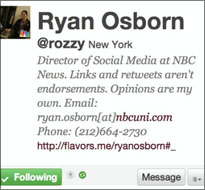While Twitter is wildly popular, too many journalists still don’t understand it.
Some are critical without ever trying it out. Others tried it when it first started out, found it lacking and never went back. Some look at folks who advocate Twitter’s use as time-wasters who are somehow less serious about their work.
A good place to start to gain a better understanding of the social networking and microblogging site is an piece by Alan Rusbridger, the editor-in-chief of the UK Guardian: “Why Twitter Matters for Media Organizations.” In it, he lays out 15 reasons journalists why should take Twitter seriously. Among them:
- Twitter is an amazing form of distribution
- It’s where things happen first
- As a search engine, it rivals Google
- It’s a formidable aggregation tool
- It’s a great tool for reporting.
Below is a compilation of ideas — many of them found, of course, on Twitter itself — for how journalists can use Twitter in smarter ways.
Upgrade your bio
The bio section of your Twitter account tells visitors about you, yet so many accounts don’t even have the full name is spelled out.
This posts’s image is a screen grab from the account of Ryan Osborn (@Rozzy), the first social media director of NBC News who used to run the giant @TodayShow account. What he does right:
- His full name, spelled out
- His title, in full
- His e-mail address and phone are included
- A link to a personal Web page (if you don’t have one, link to your news org’s site)
- A recognizable photo.
One note: His disclaimer — “Links and retweets aren’t endorsements. Opinions are my own” — make sense at a major network like NBC, but in the years ahead it will be obvious that links aren’t endorsements.
Having an email address in your Twitter bio allows you to connect with sources faster. In a Twitter case study, I wrote about journalist Amy B. Wang (@AmyBWang) doing just that.
Photos play a big role in people’s perceptions on Twitter, especially because they are most likely to see you first in that format. Use a clear, recent close-up shot of your face and avoid shots of you with a celebrity, national monument, pet or child. (In April 2010 I wrote a column about the importance of your profile photo.)
Upgrade your lists
Twitter’s list feature is a terrific tool for journalists who want to improve the service’s signal-to-noise ratio. For example, my list of 80-plus social-media editors around the country is filled with useful tweets from journalists whose job includes social-media work.
Think through your tweets
People who read your Twitter feed are going to make judgment calls about you based on what you tweet. While no one cares about what you ate for lunch or who you are hanging out with, no one is asking you to be an automaton, either, tweeting only about the work-related stuff. Think through what your account is going to feature — perhaps one or two categories of topics — and tweet those. While you are it, you can include in your Twitter bio what you are going to be tweeting about. My bio, for example, says “tweeting about tech, media and more.”
Study others’ Twitter feeds
If you are meeting a potential source or employer, one of the most important steps you can take is to study his or her Twitter feed (if one exists). It’s a smart way to get to know the other person’s interests, background and what he/she is working on. Not only will that help you find something — or many things — to connect about, but it can also tell you what to avoid. For example, a source I was going to connect with had a recent death in his family and tweeted about it; I decided to postpone my interview request.
In addition to reading others’ feeds, it’s also a good idea to see who they’re reading. One fast way to do that is t4bp.com (Twitter for Busy People), which lets you to put in a person’s name and gives you a visual presentation of everyone he/she is following.
Be nice
The Daily Beast‘s Ben Crair (@BenCrair) says in a post a media criticism that Twitter messages are “turning journalists into sniggering cheap-shot artists.” Whether you agree or not, the lesson is the same on Twitter as in real life: Don’t be a jerk.
Sree Sreenivasan is a professor and dean of student affairs at Columbia Journalism School as well as a contributing editor of DNAinfo, from which this post was adapted.
Tags: training, social media


Expert Commentary